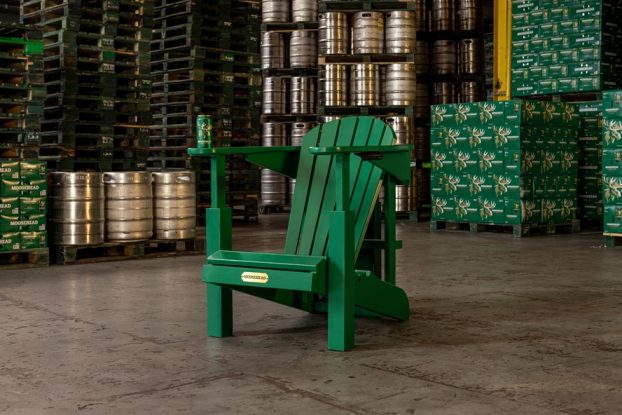Tractor manufacturers, seed sellers, fertilizer producers and pesticide makers are just some of the people who know that selling products to farmers is not easy – they don’t trust strangers, they’re hard to reach, and they want maximum value for their money. But over the years sales reps for these companies have found one simple way to make themselves welcome on family farms: giveaways. From pens to hats and jackets to calenders, farm inputs sales people are giving something away.
Corporate swag is so popular that one ag-marketer told me a running joke: How come farmers don’t wear running shoes? Because none of the agri-chem companies are giving them away. He also told me a joke a farmer with a sense of humour told him, about sending his kids to the local post office to pick up goodies in the mail, instead of buying birthday presents.
As rural Canada evolves with the times, so has rural marketing.
Gone are the days when small mixed farms dotted the land. Today’s farmers are running multi-million dollar operations from their home offices.
Numbers released by Stats Canada in May showed that one out of every 10 Canadian farms had shut down between 1996 and 2001, up seven times from five years previous, while production continues to increase.
A typical cash crop farmer in western Canada now farms 4,000 acres of land (that’s about 16 square kilometers), and a wheat farmer on the prairies might farm 6,000 acres (24 sq. km). CB radios have given way to cell phones. Sophisticated air seeders have taken the place of soil-disturbing discers used for seeding.
Some farmers are using global positioning systems on their tractors to keep track of seed, fertilizer and pesticide inputs and yields with sophisticated mapping technology on their home computers.
Sales reps used to drive pick-up trucks around the country making coffee visits at farmhouses. They still do that, but they’ve usually made an appointment ahead of time, sometimes even for a telephone call. Farmers are busy people, they’re educating themselves constantly and their time is at a premium.
‘Ag producers are an interesting mind-set,’ says Len Kahn. ‘We always debate internally: are they consumers? Or is this business-to-business? At the end of the day, these guys are buying inputs that could dramatically affect the outcomes of their operation. You can’t go over the top and be light and fluffy with your marketing. On the other hand, if you go at it like hardass B2B, that doesn’t work either.’
Kahn makes a fairly good summary of Canada’s agriculture producers, growers, or whatever you prefer to call them. Formerly the founder and president of Kahntact Marketing in Guelph, Ont., Kahn now heads up the Guelph branch of AdFarm. The Calgary-based agri-marketing firm bought Kahntact in July. With an expected $65 million in billings next year and projected revenues of $6 million, AdFarm is now the largest ag-exclusive agency in North America, with offices in Kansas City, Mo. and Fargo, N.D.
To someone who’s been in the business for a few years, the demographic changes are striking. Some are simple. The average farmer is 58 years old and there aren’t very many young ones. Farmers in the east tend to have more livestock and work year round. Western farmers are typically grain producers who are busiest from April to November. Farmers are stable. They don’t move around too often and they don’t suddenly change the crops they grow or the type of livestock they raise.
That said, one of the major changes Kahn has seen is a drastic increase in specialization. That makes each farmer unique, and on top of that, extremely sophisticated in his area of business.
‘There is no typical farmer,’ he says. ‘We’ve found it’s much easier to get a grasp of a consumer market and develop a marketing plan based on that information. With farmers, two neighbors could both be dairy farmers, but both will be vastly different decision makers.
‘The only reason to be a farmer is you get to run your own show and think independently.’
For starters, they like to read
On top of demographic changes, increasing product parity across multiple seed, pesticide, herbicide and equipment companies means that giveaways not only have to get you to the kitchen table, they have to be strategic. Where farmers once got most of their information from coffee row (that’s a prairie term for morning coffee at the local café) or from retailers and sales reps, statistics show that they now prefer to do their own research first.
‘There’s no Print Measurement Bureau for agricultural publications, but the last Ipsos-Reid omnibus survey shows by a wide margin that farmers prefer to read first, then go to trade shows, then talk to people or visit with a sales rep,’ Kahn says.
Regional farm publications serve that need, from the Saskatoon-based Western Producer (Canada’s largest farm-based weekly, catering to prairie farmers of all stripes with offices in Brandon, Man.; Calgary; Camrose, Alta.; Ottawa; Regina and Winnipeg), to Ontario’s two province-wide agricultural publications: Ontario Farmer, a weekly tabloid, and the monthly magazine Better Farming.
Manitoba has the Farmer’s Independent Weekly and the Manitoba Cooperator while B.C. has the Agri-Digest. Smaller, regional publications target more specific producers. The Ontario Fruit and Vegetable Growers Association has The Grower based in Guelph. The Dairy Farmers of Ontario publish Milk Producers Magazine.
The Internet is another place where farmers might start their research.
‘We’re doing a lot more online than we’ve ever done,’ says Kim McConnell, CEO of AdFarm in Calgary. ‘Not that they buy much online. They want to deal at home, in their local communities, but they’re certainly doing a lot more information seeking and even price seeking on the Web.’
That means there are a lot of avenues for traditional advertising. But Kahn maintains that advertising in the traditional sense doesn’t work.
‘Farmers like advertising to see what’s new. They like direct mail and trade shows that get into some depth on subjects that they’re interested in. But the advertising doesn’t really do anything. They’ll scan the papers to see what’s new and if they’re interested, they’ll visit a Web site or go see a dealer.’
Targeted direct mail is popular and over the years companies have built up significant customer databases; farmers are genuinely interested in what people are offering and they see the value in getting on the right mailing lists. Some companies have capitalized on showing that value to the customer right away.
M2 Communications, a Winnipeg-based advertising agency with several agricultural clients, has capitalized on its direct mail relationship with growers many times. A few years ago it ran a direct mail promotion for seed mogul Cargill in the Peace River region of B.C.
M2 created direct mailings with a word search puzzle featuring key words designed to trigger mind retention on different Cargill seed varieties. Once all 20 words were found, you could unscramble the left-over letters to reveal the answer to the question, ‘Who’s the best farmer in the Peace River region?’
A unique software program produced cards that would produce the name of the farmer who received the mailing as the answer. Once they unscrambled the puzzle, they could bring the puzzle back to Cargill retail for a discount.
‘We got over 100% return on that,’ agency president Doug Martin says. ‘That’s ridiculous, right? But we only sent it to farmers growing a certain crop. When other farmers found out about it they were phoning Cargill and asking why they didn’t get one. We had to create 30 more for people in the area.’
Winnipeg-based Monsanto Canada ran a similar promotion in the ’80s for their Avadex herbicide. Growers were mailed a right-hand work glove and a promotional brochure and questionnaire. When they mailed in their answers, they received a left-handed glove in the mail.
The response rate was over 90%. Monsanto’s head of advertising and promotions Deanna Traa says that while sales uplift was not significant, ‘the idea was novel and it created momentum for demand creation of the product.’ It also added lots of useful information to Monsanto’s growing customer database.
M2 currently runs a program using a premium yardstick for Winnipeg’s Canterra Seeds, a company that sells wheat, cereal and pulse seeds across Western Canada. Select farmers receive direct mail telling them to visit retail to pick up their free yardstick. Says Martin, ‘We’ll run out without question.’
McConnell recalls mailing cleavers and cutting boards to customers to launch a new herbicide some years ago. He’s also mailed capsules that grow into a foam version of the company’s logo when put in water.
‘We get very specific in direct mail and will even spend a considerable amount of money because we know exactly who we want to talk to. You can do things for 1,000 people that you couldn’t do for a million.’
Local promotions
Increased specialization and long distances make it difficult to talk to a large number of growers at any given time, but local promotions still go a long way.
M2 Communications has partnered with various media outlets to reach farmers at the local level. They’re currently running what they call the ‘Quarter for your thoughts’ contest for Canterra Seeds. M2 invited 14 radio stations from the Red River to the Peace River to come up with proposals to build their own interactive contests in exchange for promotional air time. The grand prize at each station is enough seed to plant a quarter section (that’s 160 acres, or 2.5 sq. km) of Canterra’s 1604 canola seed. The prize has a market value of about $10,000.
‘We left the mechanism up to the individual stations and each is different,’ says agency president Doug Martin. ‘Some are working with retailers; some are doing call-in-to-wins. CFCW in Edmonton created a tongue twister contest.’
The promotion resulted in almost 4,000 commercial mentions for Canterra in just 20 working days and is still going on. Better yet, the winner got something worth having.
Loyalty programs
Seeds, fertilizers, pesticides and other farm inputs are, of course, major buying decisions for farmers, and they’re not likely to drop a brand they like for a free hat.
To encourage season-to-season loyalty, a number of companies have launched highly sophisticated loyalty programs. Canterra Seeds runs ‘Germinating Success’ with M2 which works on a point system where buying seed varieties leads to discounts on future seed varieties. Purchases are tracked and credits are issued.
Bundling is also popular. Calgary-based Dow AgroSciences and Bayer CropScience work together through AdFarm to offer earned discounts to potato farmers through their ‘Hot Potatoes’ program.
For the last two years Monsanto has made an offer that allows growers to earn free Monsanto products when they purchase no-till equipment or retrofit their equipment to reduce tillage required when seeding. Reduced tillage means less disturbance of soil, reducing erosion, and preserving moisture. It also means weeds have to be tackled by other means. Monsanto will give growers up to 20% of the value of the equipment or the retrofit in the form of Roundup herbicide. This promotion has been well received by industry and growers alike.
Still giving it away
Even with loyalty programs, giveaways are expected from anybody that comes poking around the farm, and as with any other consumer segment, farmers aren’t interested in so-called ‘shiny shit.’ They want to be recognized when they spend a lot of time or money with a certain company, and they want to be recognized in a way that is useful to them.
‘Giveaways are the eternal question,’ Kahn says. ‘Everyone does it, but nobody really measures the effectiveness. Most companies are reluctant to get away from it. It’s a decent way for companies to enhance brand image. The 80/20 rule is really prevalent in any segment. The top 20% in any segment don’t care much about hats and jackets and pens. They want information that will help them run their operations.’
Martin, however, feels that good incentives do have an impact on people making decisions. ‘Uniqueness and functionality are really key for us,’ he says. ‘Virtually everything we come up with has a function for the person, and we wouldn’t do it any other way.’
A very functional M2 giveaway involved the ubiquitous hat. Advanta, an international seed company with offices in Winnipeg, Lethbridge, Alta. and Cranbrook, B.C., centred its summer program on a race car theme.
Trial fields were branded with checkered flags and racing shirts were designed for sales reps. A giveaway cap for farmers attending field tours mimicked the Nascar racing hat. Martin refers to it as ‘the mother of all hats,’ with a checkered flag on the peak and 14 or 15 different embroidered brand names of different Advanta seed varieties, copying the logo-ed out look of Mario Andretti.
Martin explains that the hats cost $40 to make each, even for a bulk order of 2,000. That kind of expense limits the re-order capability, making the hats limited edition and even more valuable. Hats on the prairie are so commonplace that it’s not worth making one that won’t stand out.
Monsanto has taken a different tack with its giveaways of late, by showing farmers that it cares about their ability to manage complex operations productively and profitably.
‘Our programs tend to have sustainable value in terms of brand loyalty and customer satisfaction versus a transactional or straight economic incentive. Also, I would classify them as an ‘everybody wins’ versus ‘a chance to win,’ which farmers seem to favour.’
Monsanto’s Digital Hired Hand promotion offered a free Palm handheld computer loaded with farm management software to people who purchased a certain volume of Monsanto products. In 2002, over half of Monsanto’s sales reps used the giveaway as a relationship builder or a deal closer.
Traa says that the package was well received, adding that the Palm is ‘a useful tool that most farmers don’t purchase from their disposable income.’
McConnell in Calgary is less enthusiastic about giveaways, but in a fiercely competitive market, it’s something that just won’t go away.
‘Every farmer wears a hat. That goes back eons. Now are hats out of favor? No, they’re not. You need another hat. Every farmer probably has 100s of hats, but they always need another hat.’
For most farmers, that’s still not a problem.






















